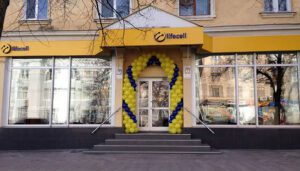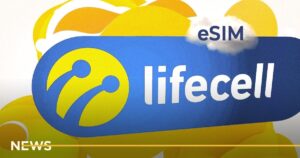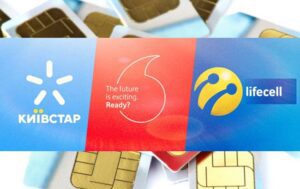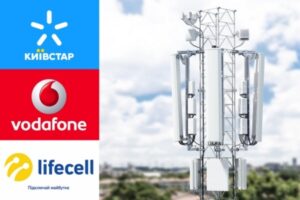
In July-September 2022, the mobile operator Lifecell LLC (lifecell) increased its revenue by 9.8% – up to UAH 2 billion 370.9 million compared to UAH 2,159.2 million for the same period in 2021.
According to a statement on the website of its parent company Turkcell, the net profit of Lifecell LLC for the specified period amounted to UAH 381.6 million, which is 2.2 times more than in July-September 2020 (UAH 173.8 million). EBITDA increased by 15.8% to UAH 1 billion 417.6 million, the EBITDA margin was 59.8% (for the same period in 2021, this figure was 56.7%).
The active three-month subscriber base of lifecell in the third quarter decreased by 7.9% – to 8.2 million subscribers. At the same time, the total number of users grew by 2%, to 10.1 million subscribers.
The company’s active three-month ARPU in the third quarter of 2022 increased by 14.9% and amounted to UAH 95.4 compared to last year’s figure of UAH 83.
Lifecell’s capital investments in July-September 2022 decreased by 10.4% – to UAH 639.6 million compared to UAH 713.7 million for the same period in 2021.
According to the report, as of September 30, 2022, the network and other equipment of the company in the regions of Ukraine occupied by Russia due to hostilities and territories controlled by Ukraine, which has not been working for more than 92 days, is out of order. “As of September 30, 2022, the amount of impairment recognized in the condensed consolidated financial statements is TL 231,472 (UAH 458,000 – IF),” Turkcell said in a statement.
As reported, according to the results of 2021, lifecell received a net profit of UAH 610.9 million, which is 4.24 times less than in 2020, while the operator’s income in 2021 increased by 24.1% to UAH 8.483 billion . The total number of subscribers of the operator at the end of 2021 amounted to 10.1 million.
lifecell is the third largest mobile operator in Ukraine. Turkcell (Turkey) owns 100% shares of Lifecell LLC.

Lifecell LLC mobile operator in April-June 2022 recorded a net loss of UAH 27.4 million compared to a net profit of UAH 116 million for the same period in 2021 due to write-offs of assets in the territories controlled by Ukraine, but not working for more than 92 days, and assets in the territories seized by Russia.
According to the parent company Turkcell, the company’s income in the second quarter of this year increased by 5.4% – to UAH 2.127 billion from UAH 2.018 billion in the second quarter of 2021, mainly due to an increase in income from international incoming calls and data transfer.
In the specified period, EBITDA increased by 8.8% – up to UAH 1.231 billion, and EBITDA margin increased by 1.8 percentage points – up to 57.9%, which the company explained with cost control measures implemented by Lifecell.
The report clarifies that the write-offs amounted to 204 million Turkish lire (about UAH 383.1 million at the rate in the report).
Lifecell’s capital investments in the second quarter of this year decreased by a third compared to the second quarter of the previous year, to UAH 659 million.
The active Lifecell subscriber base for the three reporting months decreased by 5.6%, or 500,000 – to 8.4 million subscribers, returning to the level of a year ago.
Active three-month ARPU in the second quarter of this year decreased by 1.8% compared to the previous quarter – to UAH 82.8, and MoU – by 5.5%, to 160.7 minutes. In annual terms, ARPU increased by 1.1%, while MoU fell by 14%.
“Meanwhile, three-month active 4.5G users grew by 7% year-on-year in the second quarter of 2022, to 76% of the total number of mobile data users. Lifecell maintained its leadership in the Ukrainian market in terms of smartphone penetration, which at the end of Q2 2022 reached 84.6%,” the company says.

According to the results of January-March 2022, the mobile operator Lifecell LLC (lifecell) recorded a net profit of UAH 209.4 million, which is 2.52 times more than in the same period of 2021.
According to the operator’s press service on Friday, the company’s income in the first quarter of this year increased by 21.5% – to UAH 2.307 billion from UAH 1.899 billion in the first quarter of 2021.
EBITDA at the end of the specified period increased by 20% – to UAH 1.292 billion (in the first quarter of 2021 – UAH 1.077 billion). At the same time, EBITDA margin decreased by 0.7 percentage points to 56% (56.7%).
Lifecell’s capital investments for the first three months of the year increased by 24.3% – up to UAH 711.6 million from UAH 572.4 million in the first quarter of last year.
The active three-month subscriber base of lifecell increased by 11.3% – up to 8.9 million subscribers (8 million in January-March 2021).
Active three-month ARPU grew by 7.1% year on year and amounted to UAH 84.3 (UAH 78.7 a year earlier). At the same time, the 12-month active MoU decreased by 4.1% to 170 minutes (from 177 minutes in the first quarter of 2021).
“Some of our people are fighting on the front lines. The rest, in the conditions of war, do their work during rocket attacks. As soon as our army liberates the territory from the invaders, our brigades, together with contractors, go to the destroyed facilities and resume their work. That is why the first quarter of 2022 can be proud. And I’m glad to be a part of the lifecell team and a part of Ukraine”, commented Ismet Yazidzhi, CEO of lifecell, commented on the results of the quarter of 2022.
As reported, according to the results of 2021, lifecell received a net profit of UAH 610.9 million, which is 4.24 times less than in 2020 (UAH 2.589 billion), while the operator’s income in 2021 increased by 24.1% – up to UAH 8.483 billion. EBITDA increased by 30.9% to UAH 4.751 billion, while EBITDA margin increased by 2.9 percentage points (p.p.) to 56%.
Lifecell’s capital investments in 2021 increased by 3.2% to UAH 3.594 billion.

Mobile operator lifecell records an increase in demand for eSIM during the war in Ukraine: since February 24, it has increased five times on average, and on some days subscribers ordered 20 times more digital SIM cards than before the outbreak of hostilities , the press service of the company said on Monday.
“From March 4 to March 7, the operator observed a peak in demand for eSIM – 25 times more subscribers joined the lifecell network using digital SIM cards than in the same period before the war. And the traffic from the Kherson region in the lifecell online store during this period exceeded the usual level of 44 times,” the report says.
This, the company notes, is due to the fact that lifecell remained the only operator that provided communication services in Kherson and the region during this period. Consistently high rates of digital SIM usage in March remained in the Kherson region and Kyiv.
In addition, the number of eSIM users during the war increased in Lviv and the Lviv region by almost six times compared to pre-war times.
Outside of Ukraine, the demand for eSIM has increased sevenfold. Most people bought a digital SIM card in Poland and Germany.

The Ukrainian mobile operators Kyivstar, Vodafone Ukraine and Lifecell have realized the opportunity to use mobile Internet within national roaming.
According to the joint message of the companies, distributed on Sunday, now subscribers can use not only voice calls and SMS, but also mobile 2G/3G Internet at speeds up to 512 kbps to exchange messages in instant messengers or search for information on the Internet.
National roaming allows you to connect to the network of another if the connection of one operator is lost.
“At the moment, the availability of mobile Internet is no less important than calls, because it allows you to keep in touch with loved ones online and check the latest news. At the same time, the tariffing of services in national roaming is maintained in accordance with the tariff plan of the operator whose services the subscriber uses,” the report says.
Roaming works automatically for Lifecell subscribers. If there is no connection to the network of another operator, manual settings must be made.
Kyivstar and Vodafone Ukraine subscribers can use this option by making manual settings on their smartphone and disabling auto network selection.
As noted in the message, if registration failed, you need to try again or select another network.
It is also important for subscribers to try daily to return (connect) to the network of their operator manually or by turning on automatic network selection.

Mobile operators Kyivstar, Vodafone Ukraine and lifecell together with the Ministry of Digital Transformation of Ukraine, the State Service for Special Communications and Information Protection of Ukraine, the National Commission for State Regulation in the Fields of Electronic Communications, Radio Frequency Spectrum and Provision of Postal Services together with the Ukrainian Association of Telecom Operators “Telas” announce the launch of national roaming in Ukraine.
“This means that subscribers can switch to the network of other operators if it is not possible to use the signal of their mobile operator. In the context of military aggression, mobile operators and the Ministry of Digital Transformation, State Service for Special Communications and Information Protection of Ukraine, the National Commission for State Regulation in the Fields of Electronic Communications and Telas have joined forces to ensure the continuity of communication services for their subscribers,” the joint statement said on Monday.
Starting today, national roaming between operators is launched in test mode.
“First of all, it will be connected in the zone of active hostilities (Kharkiv, Kherson, Sumy, Poltava, Dnipropetrovsk, Zaporizhia, Donetsk, Luhansk, Kirovohrad, Mykolaiv regions), then in Chernihiv, Zhytomyr, Cherkasy and Vinnytsia regions and subsequently throughout the territory Ukraine. That is, if the connection of one operator disappears, the subscriber will be able to manually connect the connection of another operator,” the message says.
Currently, national roaming is available for voice calls and SMS messages within Ukraine from all mobile operators.
For the reliable functioning of the network, operators will technically implement the possibility of using national roaming gradually. Initially, national roaming will be activated for subscribers of the contract form of service, and within the next three days, subscribers of prepaid communication will be connected.
What you need to know about using national roaming for subscribers:
– the name of the network may change to the one whose coverage is in use;
– national roaming does not require additional payment from subscribers;
– Calls and SMS are billed according to the terms of your operator’s tariff plan.
How to connect to another operator’s network:
1. Disable auto network selection, find and select an available network manually (Vodafone UA, UA-KYIVSTAR or LIFECELL). If registration fails, you need to try again or select a different network.
After connecting, it is necessary to check the possibility of passing a call, SMS.
If if is impossible to connect to the network of another operator, the subscriber should try to restart the phone.
Operators emphasize that it is important to try to return (connect) to the network of their operator every day. Manually or by enabling auto network selection.
“Please note that connecting national roaming involves a significant load on the networks of operators. This may affect the quality of some services,” the message says.